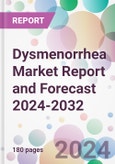Dysmenorrhea Market Outlook
The dysmenorrhea market size is anticipated to grow at a CAGR of 5.7 % during the forecast period of 2024-2032, driven by the rising incidence of PCOS and other hormonal issues across the major markets.Dysmenorrhea: Introduction
Dysmenorrhea refers to painful menstrual cramps in women, often accompanied by lower abdomen discomfort. It's divided into primary, linked to menstruation without underlying disease, and secondary, stemming from reproductive system disorders. Symptoms include sharp, throbbing, or dull pain, and may involve nausea, fatigue, and headache. Treatment typically involves pain relievers, hormonal contraceptives to lessen severity, and lifestyle changes like exercise and diet. In severe cases, especially in secondary dysmenorrhea, medical evaluation is essential for appropriate treatment.Key Trends in the Dysmenorrhea Market
There is a growing global movement towards better awareness and education about menstrual health. This trend is leading to more women seeking treatment for dysmenorrhea and a greater understanding of the condition among healthcare providers.While medication remains a primary treatment for dysmenorrhea, there is an increasing interest in non-pharmacological approaches. These include lifestyle changes, dietary adjustments, physical therapy, yoga, and acupuncture. Such treatments are gaining popularity due to their minimal side effects and holistic benefits.
The use of digital health tools, such as menstrual tracking apps and telehealth services, is on the rise. These tools help women better understand their menstrual cycle, track symptoms, and seek timely medical advice.
There is a growing trend towards personalized medicine in treating dysmenorrhea. This approach involves tailoring treatment plans to individual patient needs, considering factors like the severity of symptoms, underlying health conditions, and personal preferences.
Innovation in pain management, including new formulations of NSAIDs and other pain relief medications, is a significant trend. These advancements aim to provide more effective and longer-lasting relief with fewer side effects.
Integrative medicine, which combines conventional medical treatments with alternative therapies, is becoming more popular in managing dysmenorrhea. This approach is focused on treating the whole person, not just the symptoms.
The broader women’s health movement, advocating for better healthcare services and research focused on women’s health issues, is positively impacting the dysmenorrhea market. It's leading to more research, better treatment options, and a reduction in the stigma associated with menstrual health.
Dysmenorrhea Market Segmentation
Market Breakup by Treatment Type
- Non-steroidal Anti-inflammatory Drugs (NSAIDs)
- Hormonal Therapy
Market Breakup by Disease Type
- Primary Dysmenorrhea
- Secondary Dysmenorrhea
Market Breakup by End User
- Hospitals
- Homecare
- Specialty Clinics
- Others
Market Breakup by Region
- United States
- EU-4 and the United Kingdom
- Germany
- France
- Italy
- Spain
- United Kingdom
- Japan
Dysmenorrhea Market Overview
In the United States, the market is driven by a high awareness of menstrual health and the availability of various treatment options. The U.S. market sees a significant emphasis on over the counter (OTC) pain relievers and prescription medications, including nonsteroidal anti-inflammatory drugs (NSAIDs) and hormonal contraceptives. There's also a growing interest in alternative therapies like acupuncture and dietary supplements.Europe's market is characterized by a strong healthcare system that supports women's health. European countries generally have higher government involvement in healthcare, which influences the availability and affordability of treatments. Prescription medications are commonly used, and there's an increasing focus on holistic and lifestyle approaches, including diet modifications and physical therapy.
In Japan, cultural attitudes towards menstrual health influence the market. There's a notable preference for discretion and privacy in treatment. The Japanese market includes a mix of Western medicines and traditional Japanese treatments, like herbal remedies. The use of technology in symptom tracking and telemedicine for consultation is also gaining traction.
Dysmenorrhea Market: Competitor Landscape
The key features of the market report include patent analysis, grants analysis, clinical trials analysis, funding and investment analysis, partnerships, and collaborations analysis by the leading key players. The major companies in the market are as follows:- Novartis AG
- Bayer AG
- Abbott Laboratories
- F. Hoffmann-La Roche Ltd
- Sanofi
- Pfizer Inc.
- GlaxoSmithKline PLC
- Focus Consumer Healthcare
- Johnson & Johnson
- Alvogen
- Amgen Inc.
- Boehringer Ingelheim International GmbH.
- Ipsen Pharm
- Spectrum Pharmaceuticals, Inc.
- Takeda Pharmaceutical Company Limited
This product will be delivered within 5-7 business days.
Table of Contents
1 Preface
3 Dysmenorrhea Overview
4 Patient Profile
5 Dysmenorrhea Epidemiology Analysis - 7MM
6 Dysmenorrhea Market Overview - 7MM
7 Dysmenorrhea Market Landscape - 7MM
8 Dysmenorrhea Challenges and Unmet Needs
10 Dysmenorrhea Market Dynamics
11 Dysmenorrhea Market Segmentation - 7MM
12 United States Dysmenorrhea Market
13 EU-4 and United Kingdom Dysmenorrhea Market
14 Japan Dysmenorrhea Market
15 Regulatory Framework
16 Patent Analysis
17 Grants Analysis
18 Clinical Trials Analysis
19 Funding and Investment Analysis
20 Partnerships and Collaborations Analysis
21 Supplier Landscape
22 Dysmenorrhea Market- Distribution Model (Additional Insight)
24 Company Competitiveness Analysis (Additional Insight)
25 Payment Methods (Additional Insight)
Companies Mentioned
- Novartis AG
- Bayer AG
- Abbott Laboratories
- F. Hoffmann-La Roche Ltd
- Sanofi
- Pfizer Inc.
- GlaxoSmithKline PLC
- Focus Consumer Healthcare
- Johnson & Johnson
- Alvogen
- Amgen Inc.
- Boehringer Ingelheim International GmbH.
- Ipsen Pharm
- Spectrum Pharmaceuticals Inc.
- Takeda Pharmaceutical Company Limited
Methodology

LOADING...








